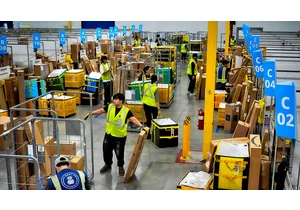Dolores Ballesteros, a Mexico-based mother of two, was getting desperate. Her 6-year-old son kept hitting his brother, age 3, and seemed angry at her all the time. No matter what she did, she couldn’t get through to him. At her lowest moments, she says, “I really thought he was acting like a psychopath.” Last Mother’s Day, she asked her husband for outside help: a subscription to the Good Inside parenting app and its AI chatbot.
Ballesteros began using the chatbot to coach her through her son’s temper tantrums in real time. It encouraged her to ask him about his feelings and embrace the most generous interpretation of his actions. “That was really good for my relationship with him,” she says. It also reminded her to set aside time for herself. “The chatbot told me that I only have so much patience,” she recalls. Today, Ballesteros feels more connected to her son and more confident as a parent, and she credits the companion in her pocket with the transformation.
Launched last August, the Good Inside chatbot is trained on the teachings of Manhattan-based clinical psychologist Becky Kennedy, known to her 3.2 million Instagram followers as “Dr. Becky.” Kennedy had a thriving practice focused on helping parents through difficult moments with their kids when she hopped onto Instagram in 2020 to share her wisdom. She quickly found an audience, especially among parents who were struggling to manage their kids in COVID lockdowns.
In her plainspoken videos, Kennedy coaches parents through common dilemmas (for example, difficult potty training, or how to speak with a teen who feels “fat”) with an emphasis on developing a healthy parent–child relationship. Often appearing in sweatpants and with messy hair, she films her videos between family therapy appointments or in the aftermath of a struggle with one of her own children, ages 13, 10, and 7. This makes Kennedy all the more relatable and equipped with actionable advice. She aims to create “sturdy” parents—who embrace their authority around their children but don’t assert it too strongly—and she frequently reminds them that their kids are essentially good, even if they act out. Using this framework, which Kennedy calls the Good Inside method, she believes parents can tackle just about anything that comes their way.
Her insights are now the basis of a growing business empire. In 2021, Kennedy and Erica Belsky, a fellow psychologist and the wife of investor and A24 Films partner Scott Belsky, cofounded the Good Inside company, which has 47 employees and plans to add an additional 18 this year. In June, Good Inside hired Daniel Shlossman, a former Uber, Sweetgreen, and Wonder executive, as its first president. Through the company, Kennedy has published a handful of books and launched a podcast. She and Belsky also created an online community where, for $23 a month or $279 annually, members can access live classes, online workshops covering everything from managing “mom rage” to building kids’ confidence, and the Good Inside app—with its OpenAI-powered chatbot, named Gigi, that’s modeled on Kennedy’s writings and videos.
The app currently has more than 80,000 members in more than 100 countries, and it’s on track to double its membership by the end of the year, according to Kennedy, putting the company’s annual run rate in the tens of millions of dollars. Most of that growth is organic, through word of mouth and Kennedy’s social media presence. Good Inside raised $10.5 million in 2023 from G9 Ventures and Inspired Capital. The company is profitable, and Kennedy and Belsky have no plans to raise more money.
“The only thing that comes naturally in parenting is [mimicking] how you were parented,” Kennedy says. But that approach doesn’t work for everyone. Kennedy says there’s no shame in enlisting tech for help. We already use AI to track our health, learn languages, and develop professional skills. Kennedy’s great insight was to deploy the technology in the service of healthy parenting.
Good Inside’s app is taking off amid rising interest in chatbot-based therapy. A handful of startups, like Wysa, have introduced conversational agents trained on cognitive behavioral therapy and other methods. Slingshot AI, which has raised $40 million from Andreessen Horowitz and others, is creating a foundational model specifically for therapy. Users of apps like ChatGPT and Character.AI, meanwhile, have been experimenting with creating therapeutic chatbots of their own.
Critics caution that there’s little research to back up the efficacy of these chatbots, and that AI can’t reliably provide accurate medical advice. (Indeed, Character.AI is facing lawsuits claiming its bots endanger children.) But since in-person therapy is more expensive than ever—averaging between $100 and $200 a session in the U.S.—and increasingly difficult to access as demand grows, the idea of harnessing chatbots to bring down costs and reach more people is appealing.
Kennedy sees her company’s chatbot as making accessible many of the lessons that she offers clients from her office. She says that the app’s subscription fee is reasonable compared with the money that people might spend on traditional therapy. “When you compare the price with anything else that involves mental wellness, the value you get far exceeds the value you’re investing.” (Parents must pay out of pocket for both Kennedy’s in-person practice and the Good Inside app.)
Even so, Good Inside’s app is more of a coach than a full-blown therapist, offering advice without becoming too personal. According to chief product officer Tiffany Shi, the only customer information the company currently stores is the ages of children, most of whom are between 2 and 12. That keeps the chatbot’s advice fairly generic. In Fast Company’s tests, many of its answers followed the Good Inside framework—assuming good intent, setting boundaries, acknowledging a child’s feelings—while adjusting the language based on a child’s age. The chatbot seemed to default to generating advice in a way that validates parents’ feelings, opening responses with lines such as “That sounds hard.”
The app has additional layers. When the chatbot delivers a response, parents have the option to click a tab to access related content. The app also includes a section similar to a Reddit board that allows users to provide moral support to one another. And there are daily bite-size lessons, delivered via swipeable cards that feature videos and written tips. Both the lessons and the AI-generated answers often include scripts that parents can use when speaking to their children. “We want parents to have a way to learn the language of parenting,” Kennedy says.
But the chatbot remains the centerpiece of the app, and Kennedy sees opportunities to bring the experience of using it closer to family therapy. Right now, “the chatbot is purely responsive,” reacting to parents’ queries, she says. But “the best help a parent could get is if the chatbot anticipates things and answers questions they don’t have yet.” She gives an example of a parent whose child keeps throwing tantrums in the grocery store: “If you always ask the chatbot what to do, it might feel like Groundhog Day. But what if the chatbot could say, ‘Let’s zoom out for a moment. Nothing is wrong with your kid, but I would love for you to jump into this four-minute video and this step-by-step guide, because this has happened a few times.’”
To create these kinds of interactions, the company would have to harvest more information about users than simply their children’s ages. Mike Krieger, Anthropic’s chief product officer and a cofounder of Instagram, serves as a mentor to Kennedy. He envisions the app developing a “memory component,” with profiles of users and their kids, based on parents’ queries. “There could be a situation where you’ve talked to [the chatbot] for long enough that you could ask it, ‘What are the thought patterns I tend to get stuck in?’” he says. (Kennedy says that data from parents’ chats would only be used to train the Good Inside chatbot.)
Personalization is on Good Inside’s road map, though the company declined to comment on a timeline or whether it would introduce subscription tiers to support such features. And there are limits to how far therapeutic chatbots can go, says John Torous, director of the digital psychiatry division at Beth Israel Deaconess Medical Center. “It’s possible to superficially customize a chatbot where it uses your name. But if you’re really looking for deep personal patterns, it takes a lot of data,” he says. “You need billions or trillions of data points to get good at learning a person.”
For now, Good Inside makes clear in its terms of use that its chatbot isn’t a therapy substitute. That’s a way to avoid liability, but it’s also a simple fact. The chatbot may not know everything about a parent’s situation, but it knows enough to offer assurances to its users that they are good parents and their children are good kids. And that might be good enough.
Login to add comment
Other posts in this group

The flash floods that have devastated Texas are already a difficult crisis to manage. More than 100 people are confirmed dead

Amazon is extending its annual Prime Day sales and offering new membership perks to Ge

How would you spend $342 billion?
A number of games called “Spend Elon Musk’s Money” have been popping up online, inviting users to imagine how they’d blow through the

On Tuesday, AI lab Moonvalley

As Elon Musk announced plans over the Fourth of July weekend to establish a third political party,

Rarely has Silicon Valley experienced a more profound period of transformation than it has in the past handful of years. The big VC boom of 2020–2021. The great VC hangover starting in 2022. The g
